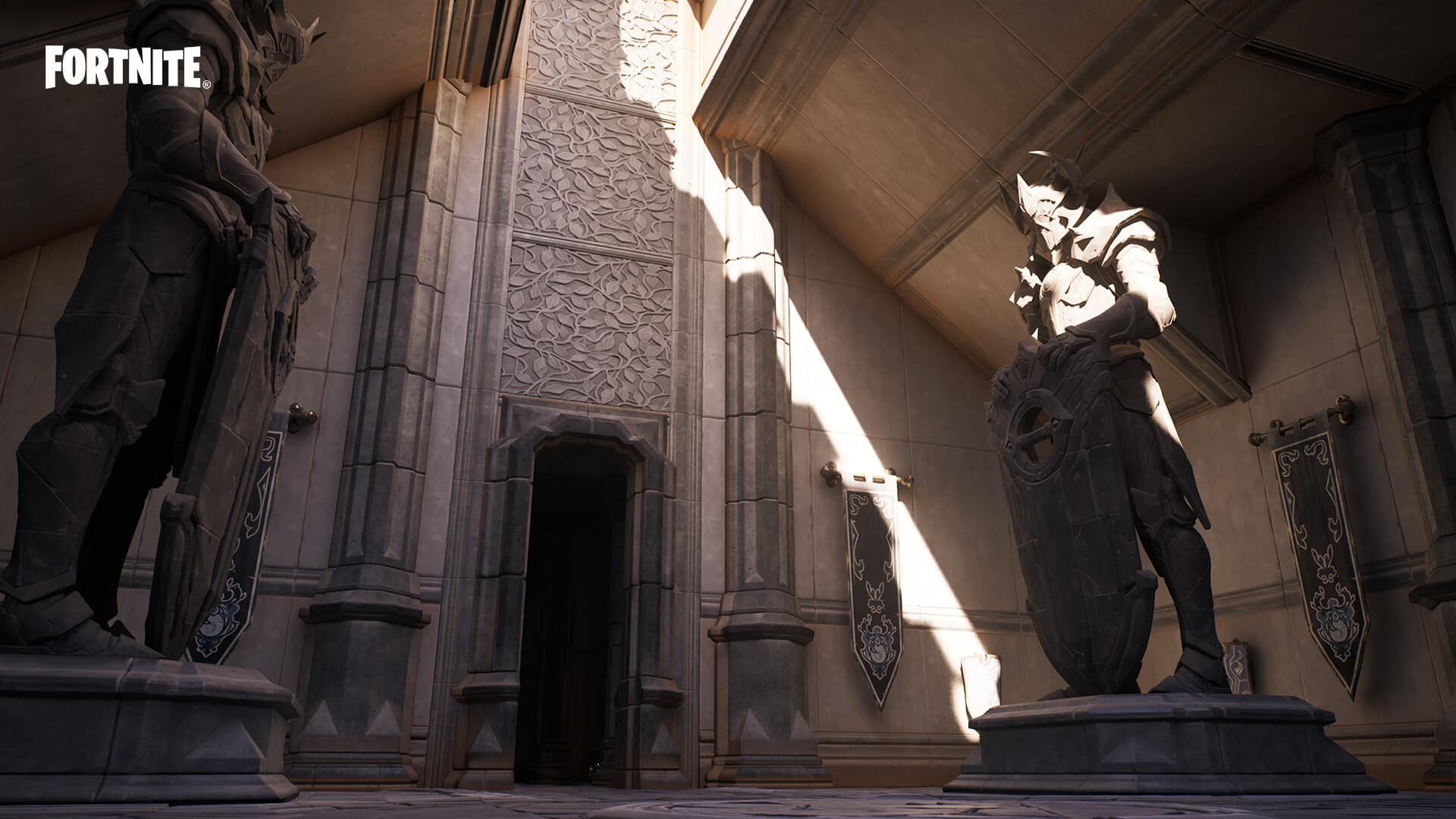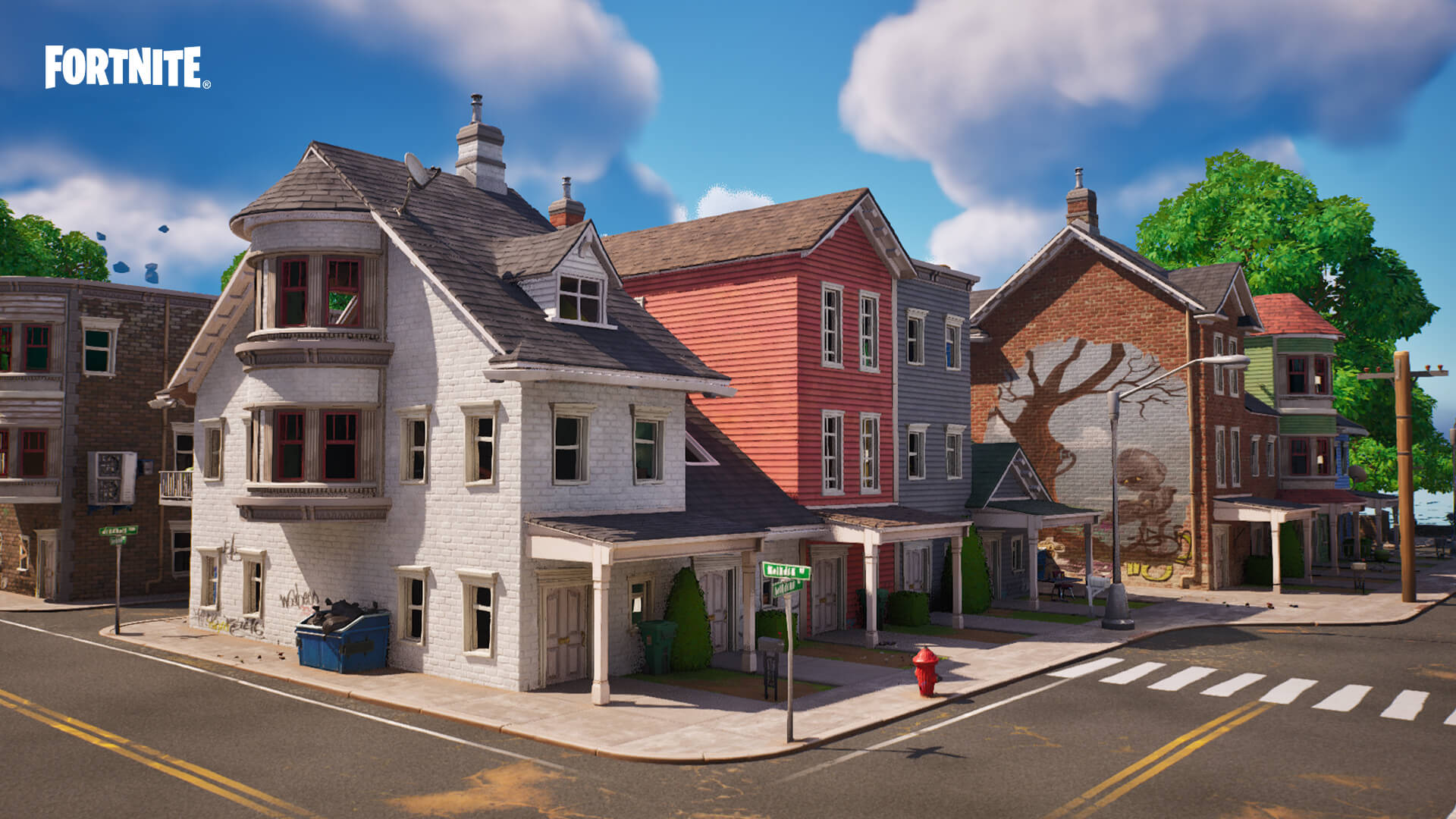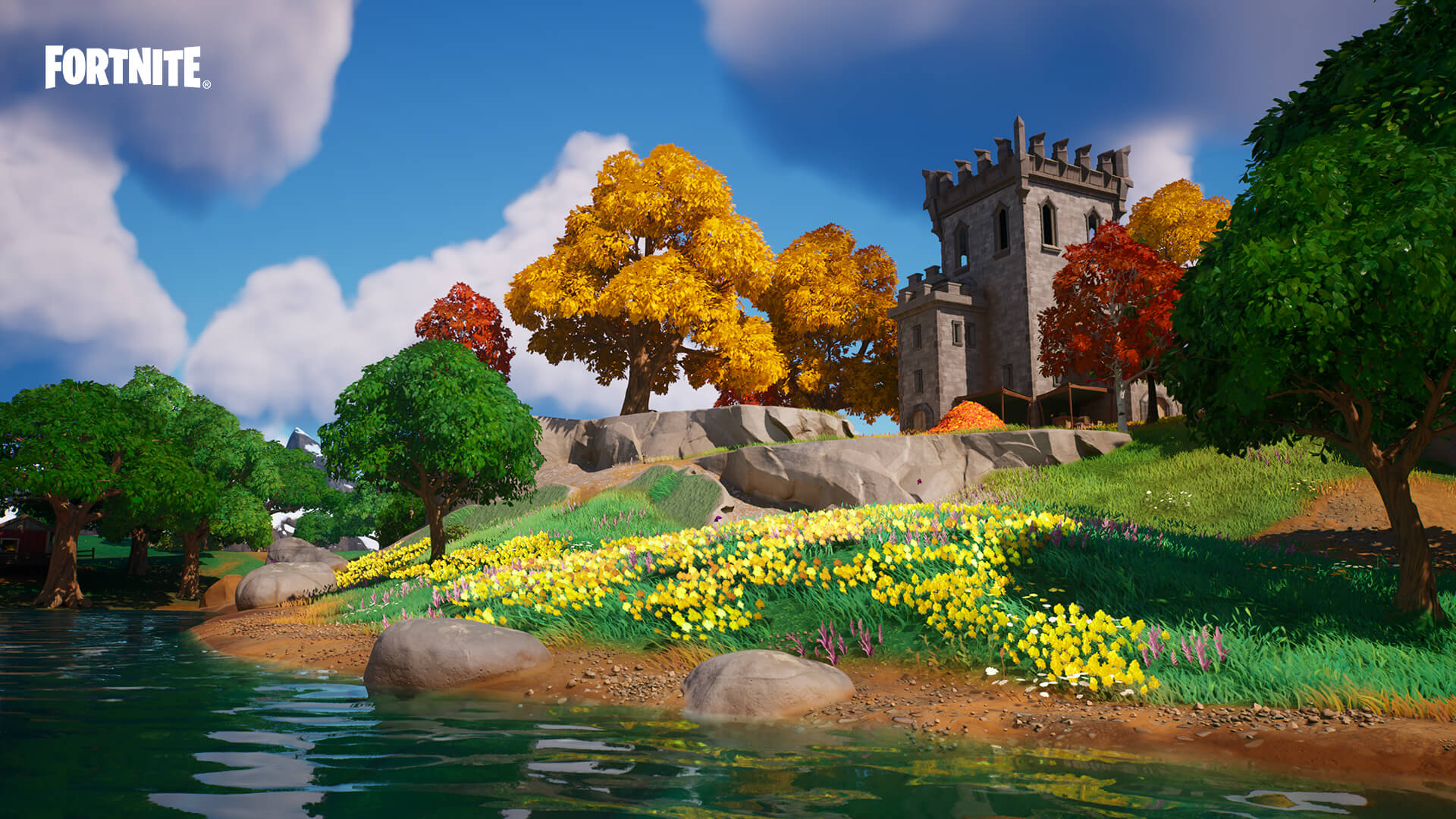
Fortnite Battle Royale Chapter 4 is here! With the release of the new Chapter, Fortnite Battle Royale now makes use of Unreal Engine 5’s newest, most innovative features, via Unreal Engine 5.1.
Unreal Engine 5 ushers in a generational leap in visual fidelity, bringing an unprecedented level of detail to game worlds like the Battle Royale Island. Next-gen Unreal Engine 5 features such as Nanite, Lumen, Virtual Shadow Maps, and Temporal Super Resolution are now available in Fortnite Battle Royale on PlayStation 5, Xbox Series X|S, PC, and cloud gaming!
Nanite, Lumen, Virtual Shadow Maps, and Temporal Super Resolution - In Detail
So what do these UE5 features do in Fortnite Battle Royale exactly? You can read the technical explanations below, or just skip to the pictures!
Nanite
Nanite provides highly-detailed architectural geometry. Specifically, buildings are rendered from millions of polygons in real time, and each brick, stone, wood plank, and wall trim is modeled.
Natural landscapes are highly-detailed too. Individual trees have around 300,000 polygons, and each stone, flower, and blade of grass is modeled.
Lumen
Lumen reflections provide high-quality ray traced reflections on glossy materials and water.
Also, Lumen provides real-time global illumination at 60 FPS. You’ll see beautiful interior spaces with bounce lighting, plus characters reacting to the lighting of their surroundings. (For example, red rugs may bounce red light onto your Outfit.) Also, Outfits that have emissive (a.k.a. glowing) qualities will scatter light on nearby objects and surfaces.
Virtual Shadow Maps
Virtual Shadow Maps allow for highly detailed shadowing. Each brick, leaf, and modeled detail will cast a shadow, and character self-shadowing is extremely accurate. This means that things like hats and other small details on characters will also cast shadows.
Temporal Super Resolution (TSR)
Temporal Super Resolution is an upgrade over Temporal Anti-Aliasing in Fortnite, and allows for high-quality visuals at a high framerate.
Fortnite Unreal Engine 5: Image Showcase




Video Settings Changes on PC
With the introduction of these UE5 features in Fortnite Battle Royale, Fortnite’s Video settings have changed on PC:
“Display” Section of the Video Settings
“Rendering Mode” Setting
-
Moved from the “Advanced Graphics” section to the “Display” section.
-
DirectX 12 is now the default rendering mode on PCs with certain higher-end GPUs.
-
The "Performance" rendering mode is no longer in beta and is now called "Performance - Lower Graphical Fidelity."
“VSync” Setting
-
Moved from the “Advanced Graphics” section to the “Display” section.
“Graphics” Section of the Video Settings
“Motion Blur” Setting
-
Moved from the “Advanced Graphics” section to the “Graphics” section.
-
Is now off by default.
-
“Auto-Set Quality” in the “Graphics Quality section” will never turn this setting on, but it may turn it off on a lower-spec PC.
“Graphics Quality” Section of the Video Settings
“Temporal Super Resolution” Setting
-
This settings has the following options:
-
Recommended (default): Selects the 3D resolution based on what works best for your display resolution.
-
Performance: Prioritizes frame rate over final image quality by rendering at a lower resolution.
-
Balanced: Balances the image quality versus performance.
-
Quality: Prioritizes final image quality over performance by rendering at a higher resolution.
-
Native: Allows you to render frames at the native display resolution at the expense of performance.
-
Custom: Allows you to customize the 3D resolution on a slider.
-
“Nanite Virtualized Geometry” Setting
-
Only available if the rendering mode is set to DirectX 12.
-
If “Nanite Virtualized Geometry” is turned on, Nanite will be enabled.
-
Note: When Nanite is enabled, the “Shadows” setting is renamed to “Virtual Shadows.”
-
-
Defaults to on when the “Quality Presets” setting is set to High or Epic.
-
Please note that this setting cannot be changed mid-match.
“Global Illumination” Setting
-
Enables Lumen Global Illumination when set to High or Epic.
-
When Nanite is disabled, this setting has two options: Only Off, and Ambient Occlusion. (Ambient Occlusion = Lower quality ambient lighting with darkened corners.)
-
When Nanite is enabled, two more options are added: Lumen High, and Lumen Epic.
-
Please note that this setting cannot be changed mid-match.
“Reflections” Setting
-
Enables Lumen Reflections when set to High or Epic.
-
When Nanite is disabled, this setting has two options: Only Off, and Screen Space. (Screen Space = Calculates reflections based only on what is currently shown on the screen.)
-
When Nanite is enabled, two more options are added: Lumen High, and Lumen Epic.
“Hardware Ray Tracing” Setting
-
“Hardware Ray Tracing” makes it so that Lumen Global Illumination and Lumen Reflections use hardware-accelerated ray tracing. (The “Hardware Ray Tracing” setting in the “Graphics Quality” section has replaced the “Ray Tracing” section.)
-
Is defaulted to off.
-
To turn “Hardware Ray Tracing” on:
-
Nanite must be enabled. (In other words, “Nanite Virtualized Geometry” is turned on.)
-
Either “Global Illumination” or “Reflections” must be set to Lumen High or Lumen Epic.
-
-
Turning this setting on or off requires a game restart to take effect.
“Auto-Set Quality”
-
Selecting “Auto-Set Quality” sets most Graphics Quality settings to either the Low, Medium, High, or Epic options, and also sets options for the “Global Illumination” and “Reflections” settings.
-
Sets the “Anti-Aliasing & Super Resolution” setting to either the TSR Low, TSR Medium, TSR High, or TSR Epic options, and the “Temporal Super Resolution” setting to Recommended.
Note: DLSS in Fortnite on PC is temporarily disabled as we test to ensure it works properly alongside the UE5 features.
Nanite, Lumen, Virtual Shadow Maps, and Temporal Super Resolution - FAQ
Are Nanite, Lumen, Virtual Shadow Maps, and Temporal Super Resolution also in creator-made islands and Save the World?
Nanite, Lumen, and Virtual Shadow Maps are currently not in creator-made islands or Save the World. However, Temporal Super Resolution is.
What are the minimum PC specifications to run Nanite?
-
GPU:
-
NVIDIA: Maxwell-generation cards or newer
-
AMD: GCN-generation cards or newer
-
-
Latest graphics drivers
-
Operating system:
-
Windows 10 version 1909.1350 or newer, with support for DirectX 12 Agility SDK
-
Windows 11
-
-
Direct X version:
-
DirectX 12
-
What are the recommended PC specifications to run Nanite?
-
GPU:
-
NVIDIA: GeForce RTX 2080 or newer
-
AMD: Radeon RX 5700 or newer
-
-
Latest graphics drivers
-
Operating system:
-
Latest Windows 10 version, with support for DirectX 12 Agility SDK
-
Latest Windows 11 version
-
-
Direct X version:
-
DirectX 12
-
If I'm playing Fortnite on PlayStation 5 or Xbox Series X|S, is there anything I need to do for Nanite, Lumen, Virtual Shadow Maps, and Temporal Super Resolution to be available?
For Nanite, Lumen, Virtual Shadow Maps, and Temporal Super Resolution to be available in Fortnite on your PlayStation 5 or Xbox Series X|S, make sure the "120 FPS Mode" setting (in the "Graphics" section of the Video settings) is set to off.
Content Creators, Planning to Make Fortnite Content in Chapter 4?
The visual changes on the Battle Royale Island in Chapter 4 mean your audiences can see the Island like they’ve never seen it before. If your viewers and fans have only seen you play in Performance Mode, there has never been a better time to really show them what Unreal Engine can do. On that note, we’ve got a few tips to show off Nanite and Lumen:
-
Set rendering mode to DirectX 12.
-
Auto-Set your “Graphics Quality” Video settings.
-
Adjust “Temporal Super Resolution” to find your balance between visual fidelity and frame rate based on your streaming or recording setup.
Legacy Operating System Support Changes
Starting with Battle Royale Chapter 4 Season 2, players will be required to use Windows 10 or higher in order to continue playing Fortnite natively on PC in an officially supported manner. Windows 7 and 8 will become officially unsupported in Fortnite.
As Fortnite continues to evolve, we are required to make support changes in order to grow our technology and expand the game to fulfill our vision of Fortnite's future. In older operating systems, the growing risk of security threats as well as the lack of modern features we rely on causes us to spend an increasing amount of development time on workarounds, instead of investing that time into the game itself.
For players unable to upgrade, NVIDIA GeForce NOW is an available alternative so you can continue playing Fortnite on your current Windows 7 or Windows 8 PC in an officially supported manner.